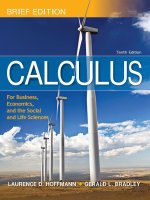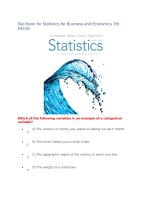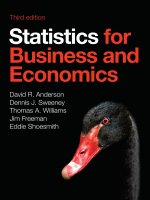Statistics for business economics 7th by paul newbold chapter 11
Bạn đang xem bản rút gọn của tài liệu. Xem và tải ngay bản đầy đủ của tài liệu tại đây (711.24 KB, 64 trang )
Statistics for
Business and Economics
7th Edition
Chapter 11
Simple Regression
Copyright © 2010 Pearson Education, Inc. Publishing as Prentice Hall
Ch. 11-1
Chapter Goals
After completing this chapter, you should be
able to:
Explain the simple linear regression model
Obtain and interpret the simple linear regression
equation for a set of data
Describe R2 as a measure of explanatory power of the
regression model
Understand the assumptions behind regression
analysis
Explain measures of variation and determine whether
the independent variable is significant
Copyright © 2010 Pearson Education, Inc. Publishing as Prentice Hall
Ch. 11-2
Chapter Goals
(continued)
After completing this chapter, you should be
able to:
Calculate and interpret confidence intervals for the
regression coefficients
Use a regression equation for prediction
Form forecast intervals around an estimated Y value for
a given X
Use graphical analysis to recognize potential problems
in regression analysis
Explain the correlation coefficient and perform a
hypothesis test for zero population correlation
Copyright © 2010 Pearson Education, Inc. Publishing as Prentice Hall
Ch. 11-3
11.1
Overview of Linear Models
An equation can be fit to show the best linear
relationship between two variables:
Y = β0 + β1X
Where Y is the dependent variable and
X is the independent variable
β0 is the Y-intercept
β1 is the slope
Copyright © 2010 Pearson Education, Inc. Publishing as Prentice Hall
Ch. 11-4
Least Squares Regression
Estimates for coefficients β0 and β1 are found
using a Least Squares Regression technique
The least-squares regression line, based on sample
data, is
yˆ b0 b1x
Where b1 is the slope of the line and b0 is the yintercept:
Cov(x, y)
b1
s2x
Copyright © 2010 Pearson Education, Inc. Publishing as Prentice Hall
b 0 y b1x
Ch. 11-5
Introduction to
Regression Analysis
Regression analysis is used to:
Predict the value of a dependent variable based on
the value of at least one independent variable
Explain the impact of changes in an independent
variable on the dependent variable
Dependent variable: the variable we wish to explain
(also called the endogenous variable)
Independent variable: the variable used to explain
the dependent variable
(also called the exogenous variable)
Copyright © 2010 Pearson Education, Inc. Publishing as Prentice Hall
Ch. 11-6
11.2
Linear Regression Model
The relationship between X and Y is
described by a linear function
Changes in Y are assumed to be caused by
changes in X
Linear regression population equation model
Yi β0 β1x i ε i
Where 0 and 1 are the population model
coefficients and is a random error term.
Copyright © 2010 Pearson Education, Inc. Publishing as Prentice Hall
Ch. 11-7
Simple Linear Regression
Model
The population regression model:
Population
Y intercept
Dependent
Variable
Population
Slope
Coefficient
Independent
Variable
Random
Error
term
Yi β0 β1Xi ε i
Linear component
Copyright © 2010 Pearson Education, Inc. Publishing as Prentice Hall
Random Error
component
Ch. 11-8
Simple Linear Regression
Model
(continued)
Y
Yi β0 β1Xi ε i
Observed Value
of Y for Xi
εi
Predicted Value
of Y for Xi
Slope = β1
Random Error
for this Xi value
Intercept = β0
Xi
Copyright © 2010 Pearson Education, Inc. Publishing as Prentice Hall
X
Ch. 11-9
Simple Linear Regression
Equation
The simple linear regression equation provides an
estimate of the population regression line
Estimated
(or predicted)
y value for
observation i
Estimate of
the regression
Estimate of the
regression slope
intercept
yˆ i b0 b1x i
Value of x for
observation i
The individual random error terms ei have a mean of zero
ei ( y i - yˆ i ) y i - (b0 b1x i )
Copyright © 2010 Pearson Education, Inc. Publishing as Prentice Hall
Ch. 11-10
11.3
Least Squares Estimators
b0 and b1 are obtained by finding the values
of b0 and b1 that minimize the sum of the
squared differences between y and yˆ :
min SSE min ei2
min (y i yˆ i )2
min [y i (b0 b1x i )]2
Differential calculus is used to obtain the
coefficient estimators b0 and b1 that minimize SSE
Copyright © 2010 Pearson Education, Inc. Publishing as Prentice Hall
Ch. 11-11
Least Squares Estimators
(continued)
The slope coefficient estimator is
n
(x x)(y y)
i
b1
i
i1
n
2
(x
x
)
i
sy
Cov(x, y)
rxy
2
sx
sx
i1
And the constant or y-intercept is
b0 y b1x
The regression line always goes through the mean x, y
Copyright © 2010 Pearson Education, Inc. Publishing as Prentice Hall
Ch. 11-12
Finding the Least Squares
Equation
The coefficients b0 and b1 , and other
regression results in this chapter, will be
found using a computer
Hand calculations are tedious
Statistical routines are built into Excel
Other statistical analysis software can be used
Copyright © 2010 Pearson Education, Inc. Publishing as Prentice Hall
Ch. 11-13
Linear Regression Model
Assumptions
The true relationship form is linear (Y is a linear function
of X, plus random error)
The error terms, εi are independent of the x values
The error terms are random variables with mean 0 and
constant variance, σ2
(the constant variance property is called homoscedasticity)
2
E[ε i ] 0 and E[ε i ] σ 2
for (i 1, , n)
The random error terms, εi, are not correlated with one
another, so that
E[ε iε j ] 0
for all i j
Copyright © 2010 Pearson Education, Inc. Publishing as Prentice Hall
Ch. 11-14
Interpretation of the
Slope and the Intercept
b0 is the estimated average value of y
when the value of x is zero (if x = 0
is in the range of observed x values)
b1 is the estimated change in the
average value of y as a result of a
one-unit change in x
Copyright © 2010 Pearson Education, Inc. Publishing as Prentice Hall
Ch. 11-15
Simple Linear Regression
Example
A real estate agent wishes to examine the
relationship between the selling price of a home
and its size (measured in square feet)
A random sample of 10 houses is selected
Dependent variable (Y) = house price in $1000s
Independent variable (X) = square feet
Copyright © 2010 Pearson Education, Inc. Publishing as Prentice Hall
Ch. 11-16
Sample Data for
House Price Model
House Price in $1000s
(Y)
Square Feet
(X)
245
1400
312
1600
279
1700
308
1875
199
1100
219
1550
405
2350
324
2450
319
1425
255
1700
Copyright © 2010 Pearson Education, Inc. Publishing as Prentice Hall
Ch. 11-17
Graphical Presentation
House price model: scatter plot
Copyright © 2010 Pearson Education, Inc. Publishing as Prentice Hall
Ch. 11-18
Regression Using Excel
Excel will be used to generate the coefficients and
measures of goodness of fit for regression
Data / Data Analysis / Regression
Copyright © 2010 Pearson Education, Inc. Publishing as Prentice Hall
Ch. 11-19
Regression Using Excel
Data / Data Analysis / Regression
(continued)
Provide desired input:
Copyright © 2010 Pearson Education, Inc. Publishing as Prentice Hall
Ch. 11-20
Excel Output
Copyright © 2010 Pearson Education, Inc. Publishing as Prentice Hall
Ch. 11-21
Excel Output
(continued)
Regression Statistics
Multiple R
0.76211
R Square
0.58082
Adjusted R Square
0.52842
Standard Error
The regression equation is:
house price 98.24833 0.10977 (square feet)
41.33032
Observations
10
ANOVA
df
SS
MS
F
11.0848
Regression
1
18934.9348
18934.9348
Residual
8
13665.5652
1708.1957
Total
9
32600.5000
Intercept
Square Feet
Coefficients
Standard Error
t Stat
Significance F
0.01039
P-value
Lower 95%
Upper 95%
98.24833
58.03348
1.69296
0.12892
-35.57720
232.07386
0.10977
0.03297
3.32938
0.01039
0.03374
0.18580
Copyright © 2010 Pearson Education, Inc. Publishing as Prentice Hall
Ch. 11-22
Graphical Presentation
House price model: scatter plot and
regression line
Slope
= 0.10977
Intercept
= 98.248
house price 98.24833 0.10977 (square feet)
Copyright © 2010 Pearson Education, Inc. Publishing as Prentice Hall
Ch. 11-23
Interpretation of the
Intercept, b0
house price 98.24833 0.10977 (square feet)
b0 is the estimated average value of Y when the
value of X is zero (if X = 0 is in the range of
observed X values)
Here, no houses had 0 square feet, so b0 = 98.24833
just indicates that, for houses within the range of
sizes observed, $98,248.33 is the portion of the
house price not explained by square feet
Copyright © 2010 Pearson Education, Inc. Publishing as Prentice Hall
Ch. 11-24
Interpretation of the
Slope Coefficient, b1
house price 98.24833 0.10977 (square feet)
b1 measures the estimated change in the
average value of Y as a result of a oneunit change in X
Here, b1 = .10977 tells us that the average value of a
house increases by .10977($1000) = $109.77, on
average, for each additional one square foot of size
Copyright © 2010 Pearson Education, Inc. Publishing as Prentice Hall
Ch. 11-25









